Did you know that your skin is your body’s largest organ?! Given the amount of sun we get living in Southern California, in addition to daily sunscreen application, Dr. Bita Bagheri highly recommends annual full body skin exams starting in the early teen years. Between junior guards, swim team, playing golf, gardening, tennis, and just sitting in the car, we get a lot of sun exposure.
During these non-invasive exams, dermatologists are able to detect skin cancer or skin pre-cancers:

- Basal Cell Carcinoma
- Squamous Cell Carcinoma
- Malignant Melanoma – the most lethal of the three skin cancers.
Basal Cell Carcinomas
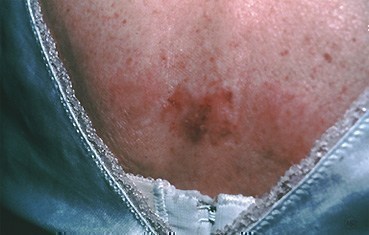
Your skin’s basal cells line the deepest layer of the outermost layer of your skin, which we call the epidermis. Basal Cell Carcinomas are abnormal, uncontrolled growths (doctors call them lesions) appearing in the basal cells. Basal Cell Carcinomas can often appear like open sores, pink growths, red patches, shiny bumps, or scars.
Regularly spending a ton of time in intense as well as the occasional really bad sun burn causes Basal Cell Carcinoma.
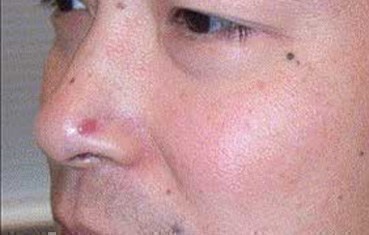
Basal Cell Carcinoma rarely spreads (metastasizes) beyond the original site, though in very rare cases, it’s been known to spread to other parts of the body and be life-threatening. If not treated right away, this type of skin cancer can leave disfigurations on the skin as the tumor grows in size and the doctor needs to remove it all.
4 million+ patients in the US are diagnosed each year with Basal Cell Carcinoma and is the most commonly occurring forms of all cancers.

Approximately 35% of new cancer diagnoses are skin cancer, with the majority being Basal Cell Carcinoma.
Squamous Cell Carcinoma
Squamous Cell Carcinoma is the second most common form of skin cancer. The uncontrolled growth of abnormal cells arising in the epidermis, the outermost layer of your skin, is called Squamous Cell Carcinoma. You’ll sometimes hear it referred to as Cutaneous Squamous Cell Carcinoma to mark its difference from very different kinds of SCCs found elsewhere in the body. We doctors say cutaneous which refers to the skin.
Squamous Cell Carcinoma often appears as scaly red patches, open sores, warts or elevated growths with a central depression. They may be found to crust over or bleed. If not treated right away, they can disfigure or even be deadly.
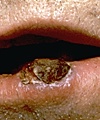
“More than 1 million cases of squamous cell carcinoma are diagnosed each year in the U.S., which translates to about 115 cases diagnosed every hour. Incidence has increased up to 200 percent in the past three decades in the U.S., and more than 15,000 Americans die each year from the disease.” Skin Cancer Foundation
Cumulative, long-term exposure to ultraviolet (UV) radiation from the sun or tanning beds over long periods of time causes most Squamous Cell Carcinomas. For those living in sunny locations like Southern California, year-round sun exposure, intense exposure in the summer months or during sun-laden vacations all accumulate in your skin, which can lead to Squamous Cell Carcinoma. Tanning beds are the leading reason for increased Squamous Cell Carcinoma in young women.
While Squamous Cell Carcinomas usually occurs on parts of your body frequently exposed to the sun, it can occur on any part of your body, including your mucous membranes and genitals. Clues to look for are wrinkles, freckles, dark spots, age spots, pigment discoloration, broken blood vessels and loss of your skin’s elasticity.
Melanoma : The ABC’s of Melanoma, courtesy of skincancer.org
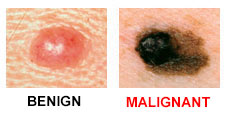
Asymmetry : Melanoma moles are irregularly shaped
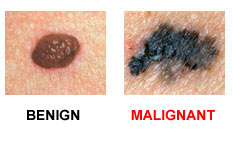
Borders : Melanoma has irregular borders
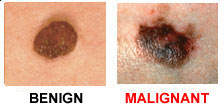
Color : Melanoma is multi-colored
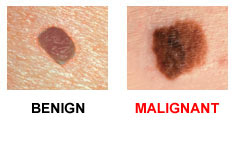
Diameter : Melanoma is larger in size
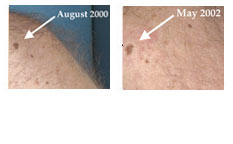
Evolving : Melanoma changes over time
While Basal Cell Carcinoma and Squamous Cell skin cancers are most often seen in people who spend a lot of time in the sun, Melanomas are generally related to “vacation burns” and are genetically predisposed in patients.
Melanoma is a fast killer and is the #1 cause of cancer-related deaths in women in their 20s.
Research shows that patients who catch melanoma in its early stages, before spreading to lymph nodes, have excellent survival rates of 95% after 5 years.
We wholeheartedly believe that annual skin cancer checks are vital to your long-term health, especially for those of us living in the Southern California. While you may not realize it, waiting in carpool, sitting in traffic, watching your kids’ games, and playing golf each weekend has a major impact on your skin’s health! We’re happy to help you. Please contact us for an appointment.
